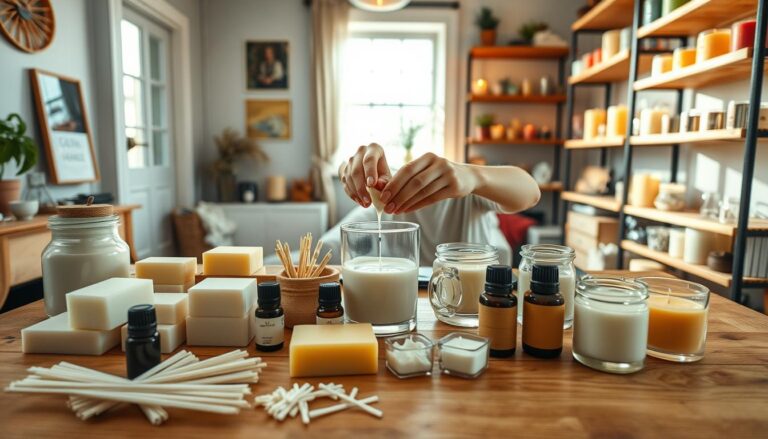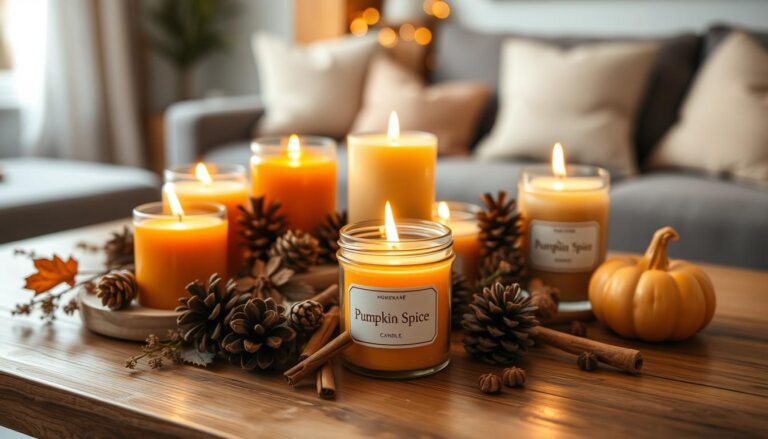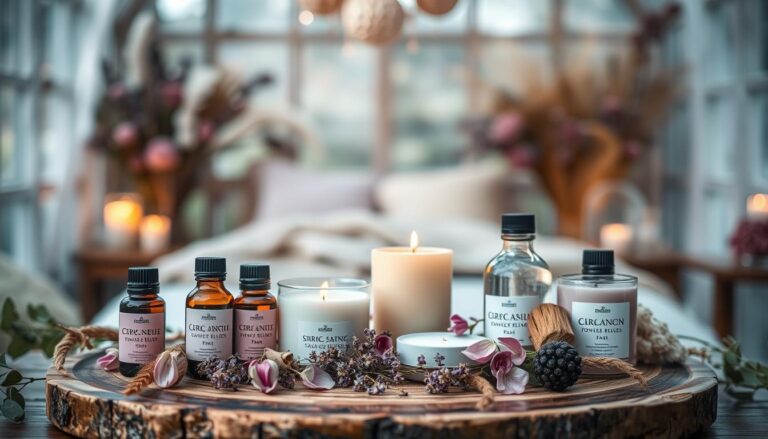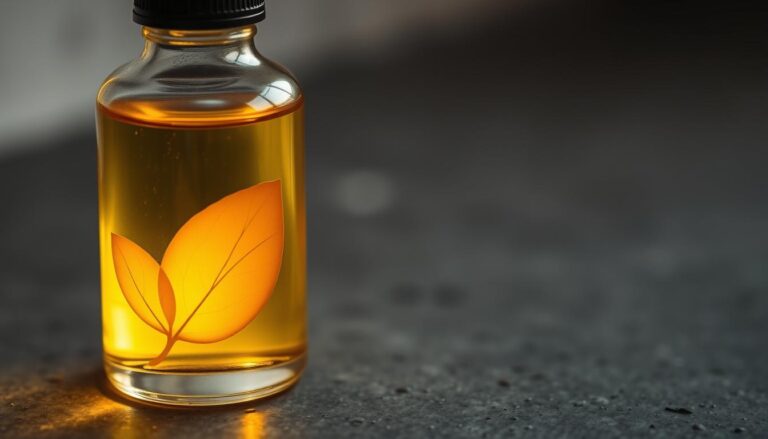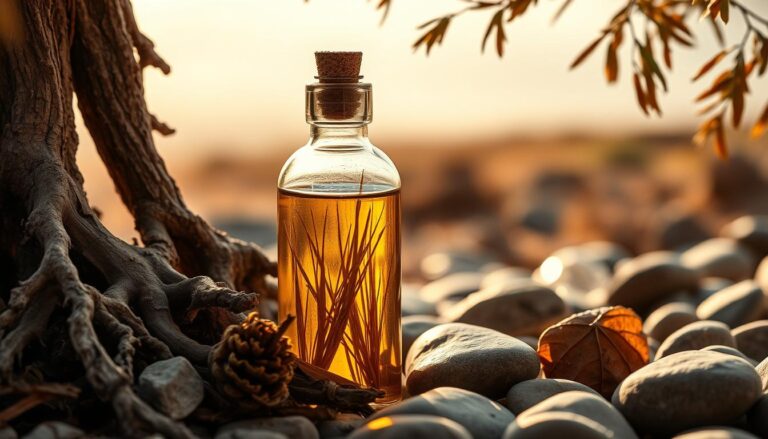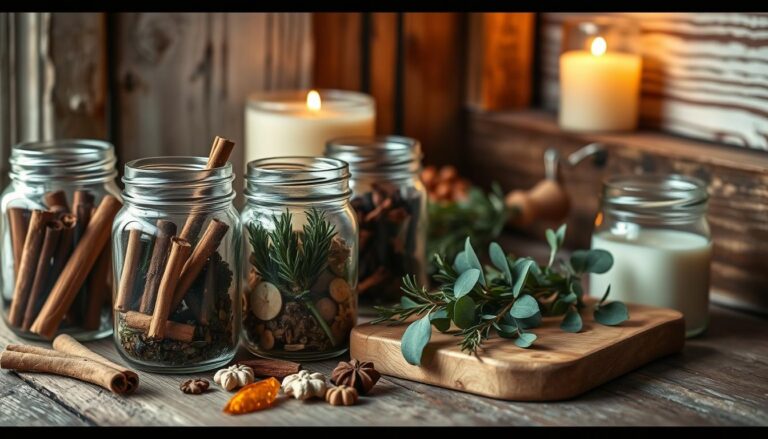Looking for a gift that combines creativity and practicality? A custom essential oil blends kit might just be the answer.
Everybody loves a gift that feels personalized and that’s why aromatherapy kits are great as they let you craft something truly special.
These handcrafted sets offer recipients a chance to explore scents tailored to their preferences, whether they seek relaxation, energy, or a touch of luxury.
This guide shows you how to assemble professional-quality gift sets without breaking the bank.
You’ll learn to select the right number of ingredients, pair complementary scents, and design packaging that wows.
From calming lavender to zesty citrus, each element can reflect the recipient’s personality or needs.
Why are these kits gaining popularity? They’re perfect for birthdays, weddings, or holidays—any occasion where thoughtfulness matters.
Unlike store-bought options, your creation becomes a memorable experience. Imagine pairing floral notes with earthy undertones or designing blends for specific moods.
The possibilities are endless.
We’ll cover everything from choosing glass bottles to writing clear instructions. You’ll even discover how to incorporate diffuser recipes or seasonal themes.
By the end, you’ll have all the tools to turn simple oils into heartfelt gifts that stand out.
Key Takeaways
- Personalized kits let recipients enjoy unique aromatherapy experiences
- Tailor scents to match moods, seasons, or specific preferences
- Cost-effective alternative to pre-made luxury products
- Includes tips for professional packaging and clear usage guides
- Ideal for holidays, weddings, or sentimental surprises
- Combine floral, citrus, and earthy notes for balanced blends
Unleash Your Creativity with Essential Oil Blending
Dive into the art of scent creation where every drop tells a unique story.
Blending aromas combines playful experimentation with practical science, letting you craft fragrances that resonate with your mood or occasion.
Whether you spend five minutes or five hours, this process becomes a form of self-expression.
You’ll find endless ways to mix earthy, floral, and citrus notes.
Start with three ingredients.
For instance:
- bergamot,
- cedarwood,
- rosemary.
Adjust the number of drops until the aroma feels balanced. There’s no wrong answer here, just trust your instincts as you layer top, middle, and base notes.
This practice connects you to centuries-old traditions while solving modern needs. Create citrus essential oil blends to drive up energy and focus.
For instance, a morning pick-me-up with zesty grapefruit.
Design evening relaxation using chamomile and sandalwood. Each blend becomes a personal remedy or mood enhancer.
Keep sessions stress-free by starting small. Use two oils at first, noting how their scents evolve when combined.
With time, you’ll intuitively pair ingredients for specific effects.
The journey itself becomes meditative. It’s a chance to slow down and engage your senses.
Your creations can transform everyday routines into luxurious atmospheres and rituals: Diffuse them during yoga, add to bath salts, or gift them in beautiful bottles.
Every whiff carries the satisfaction of having crafted something uniquely yours.
Understanding the Basics of Essential Oil Blending
Ever wondered how plants bottle their magic? These concentrated extracts pack nature’s power into tiny bottles.
Let’s explore what makes them special and why blending your own versions beats store-bought options.
What Are Essential Oils?
Plants contain aromatic compounds that get captured through steam or pressure.
These methods preserve the plant’s natural benefits.
For example, citrus peels release oils through cold pressing, while delicate flowers often need steam distillation.
| Extraction Method | Best For | Oil Yield |
|---|---|---|
| Steam Distillation | Lavender, Eucalyptus | High |
| Cold Pressing | Orange, Lemon | Medium |
| Solvent Extraction | Vanilla, Jasmine | Low |
Benefits of Crafting Your Own Blends
Personalized mixtures let you choose every ingredient. You decide the strength and scent profile.
Want a calming mix for bedtime? Combine lavender with cedarwood using three parts to one.
Store blends lose potency over time. Fresh combinations retain their effectiveness longer when stored properly.
Dark glass bottles protect against light damage, keeping your creation vibrant.
Costs drop when you mix scents yourself. Pre-made products often charge for packaging and branding.
With basic supplies, you can recreate favorite recipes endlessly without markup.
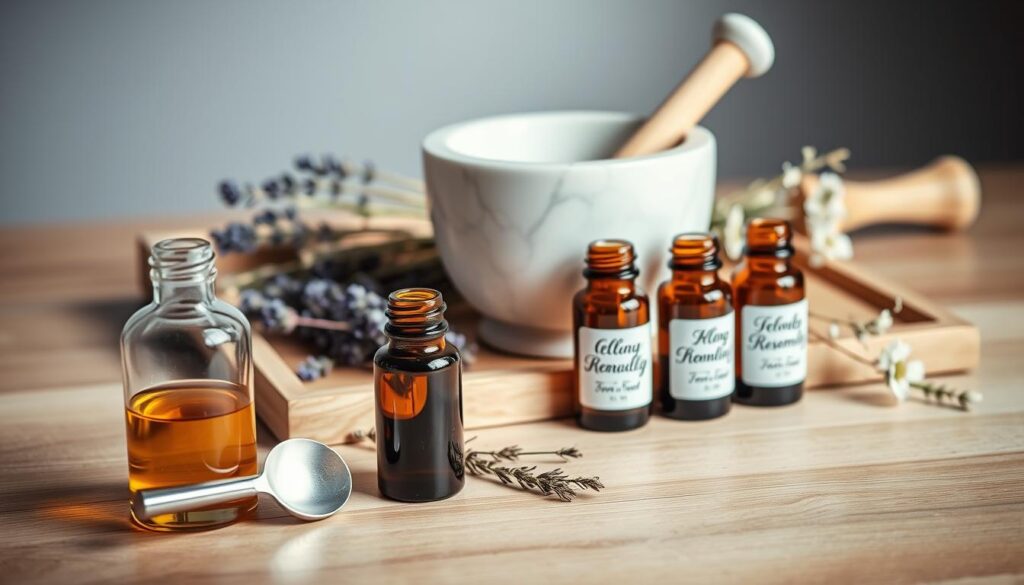
Essential Oil Blending Tools and Supplies
Every great blend starts with the right tools and quality ingredients.
Gathering these essentials ensures your aromatic experiments stay safe, precise, and enjoyable.
Let’s explore what you’ll need to begin your scent-crafting journey.
Must-Have Extracts for Success
Begin with versatile options like lavender, lemon, and peppermint.
These staples form the foundation for countless combinations.
Add specialty picks such as organic rose or helichrysum for unique twists.
If you are thinking of making candles, aim for 5-7 varieties covering different scent categories: citrus, floral, and earthy tones work well together.
Beyond the Basics
Protective gloves shield your skin from concentrated formulas.
Glass droppers help measure ingredients drop by drop for accuracy.
Use small amber bottles to store test batches as they prevent light damage better than plastic.
Perfume blotters let you track how aromas change over hours. Don’t forget a notebook to document ratios that work!
Keep towels nearby for spills and labels for organization.
Your nose remains the star player. Take breaks between tests to avoid scent fatigue. With these supplies, you’re ready to craft harmonious creations.
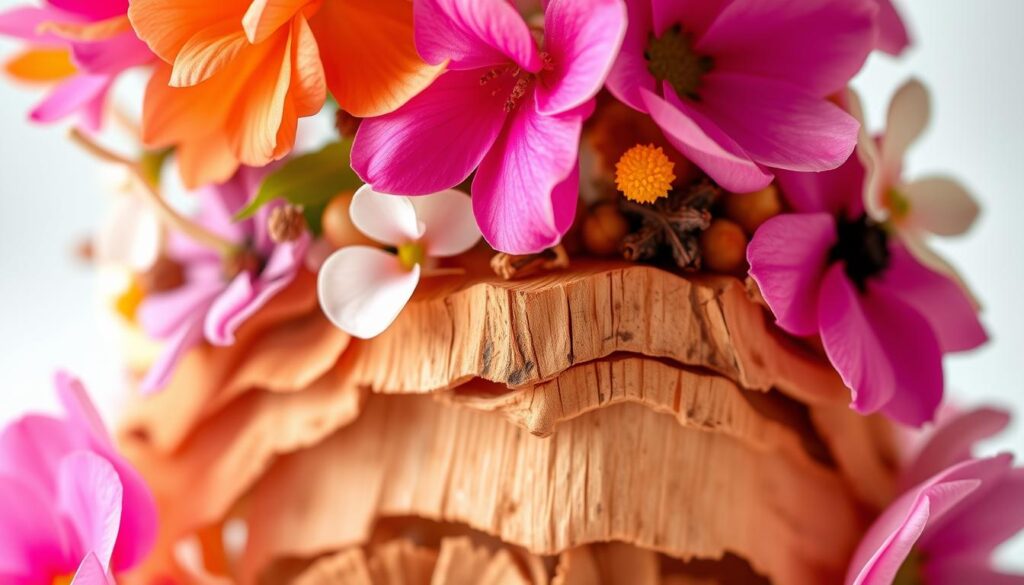
Grasping Fragrance Notes: Top, Middle, and Base
Unlock the secret to professional-quality scent combinations by mastering fragrance layers.
Just like music needs rhythm, melody, and harmony, your aromatic creations thrive on three-tiered structures that evolve over time.
Recognizing the Role of Each Aroma Layer
Think of top notes as your first impression, bright and energetic.
Citrus bursts like lemon or sweet orange grab attention but fade within 15 minutes. These volatile ingredients create that initial “wow” factor before stepping aside.
Middle notes form the heart of your composition. Floral choices like rose or geranium emerge as top notes dissipate, lasting several hours.
They bridge fresh openings with deeper undertones, creating emotional connections through balanced warmth.
Base notes act as your foundation. Rich earthiness from cedarwood or vanilla lingers for days, stabilizing lighter elements.
These heavy molecules slow evaporation rates, ensuring your creation maintains character long after application.
| Note Type | Duration | Common Choices |
|---|---|---|
| Top | 15-30 min | Lemon, Eucalyptus, Peppermint |
| Middle | 2-4 hours | Lavender, Jasmine, Chamomile |
| Base | 24+ hours | Sandalwood, Patchouli, Vetiver |
Balance your ratios using a 3:2:1 approach—three drops top, two middle, one base.
This ratio prevents heavier ingredients from overwhelming delicate citrus tones.
Test combinations on perfume blotters to observe how layers interact over hours.
When substituting ingredients, match note categories rather than exact scents.
Swap bergamot for grapefruit in top layers, or replace vanilla with tonka bean in base foundations. This flexibility lets you craft unique profiles while maintaining structural integrity.
How to make custome essential oil blends
Perfecting your aromatic creations begins with patience and precision.
Start by mixing tiny quantities, think 10 drops total, to test combinations without wasting resources.
This approach lets you tweak ratios easily while protecting your investment in quality materials.
Each unit represents 10% of your trial mixture, simplifying math when scaling recipes.
Keep a detailed journal noting every addition: two parts lavender, one part bergamot, for example.
This record-keeping habit ensures repeatable success and helps avoid repeating unsuccessful attempts.
Why risk precious materials on large batches? Small tests allow bold experimentation with unusual pairings.
If a combination misses the mark, you’ve only used minimal amounts.
When you strike gold, multiply the formula confidently knowing it’s been thoroughly vetted.
Precision matters, so count each measurement carefully using a pipette or glass dropper.
Label containers immediately with dates and ratios to maintain organization.
Over time, this disciplined method sharpens your intuition for balancing top, middle, and base notes effectively.
Step-by-Step Guide to Crafting Custom Blend Kits
Transform simple ingredients into signature aromas with this easy blending method. Start with a clean glass bottle and your chosen extracts.
The process flows from foundational elements to finishing touches, ensuring every whiff evolves beautifully.
Initial Testing and Measuring Drops
Begin with base notes like cedarwood or vanilla. Add 1-3 drops using a precise dropper.
These deep tones anchor your creation.
Next, layer 2-4 drops of middle notes such as lavender or chamomile.
Their floral warmth bridges fresh openings with earthy undertones.
Finish with bright top notes like lemon or bergamot.
Test combinations on cotton balls to observe how the scent changes hourly. Adjust the number of drops until citrus zing complements woody depth without overpowering.
7 beginner-friendly essential oil blend recipes
Here are 7 simple essential oil blend recipes that are easy to mix, match, and customize.
Each recipe totals 20 drops, ideal for 8 oz candles, diffusers, or 100 ml room sprays.
These blends are simple, balanced, and versatile, making them perfect for learning how oils work together.
Customization Tip for Beginners:
- Swap one oil at a time to learn what each scent contributes.
- Start with 10–15 drops if using for skin or sensitive applications.
- Test in a diffuser first before using in candles or sprays.
🌸 1. Bright Morning
- 10 drops Sweet Orange
- 6 drops Lemon
- 4 drops Peppermint
☀️ Energizing and fresh. Great for kitchen or morning routines.
🌿 2. Balanced Calm
- 8 drops Lavender
- 6 drops Bergamot
- 4 drops Geranium
- 2 drops Patchouli
💜 Soothing, floral, and grounding—great for any time of day.
🍋 3. Citrus Clean
- 8 drops Lemon
- 6 drops Grapefruit
- 4 drops Tea Tree
- 2 drops Eucalyptus
🧼 Refreshing and purifying. Perfect for cleaning blends and bathrooms.
🌾 4. Sleepy Time
- 10 drops Lavender
- 6 drops Chamomile
- 2 drops Cedarwood
- 2 drops Frankincense
🌙 Relaxing and warm—ideal for evening or pillow sprays.
🌹 5. Romantic Bloom
- 6 drops Ylang Ylang
- 6 drops Geranium
- 4 drops Sweet Orange
- 4 drops Lavender
💐 Floral and sensual. Great for bedrooms and bath soaks.
🌲 6. Forest Fresh
- 8 drops Fir Needle
- 6 drops Cedarwood
- 4 drops Eucalyptus
- 2 drops Spearmint
🌳 Crisp and woodsy. Great for grounding energy or seasonal blends.
🧖♀️ 7. Spa Revival
- 8 drops Eucalyptus
- 6 drops Peppermint
- 4 drops Lavender
- 2 drops Rosemary
💆 Clean, invigorating, and perfect for steam showers or diffusers in bathrooms.
Balancing Aromatic Notes for a Perfect Scent
Let your trial blend sit for 24 hours before finalizing.
Base notes strengthen over time, while top layers fade gently.
If the heart feels weak, add one more drop of middle-note ingredient.
For overly sharp aromas, increase base drops by 20%.
Label each bottle with exact ratios and creation dates.
This helps recreate winning formulas and track how scents mature. With practice, you’ll instinctively balance layers for lasting harmony.
FAQ
How many drops should I use when creating a new blend?
Start with 2-3 drops per oil to test combinations. Adjust ratios gradually, keeping total drops between 10-15 per 10ml carrier oil to avoid overpowering scents.
Can I substitute eucalyptus radiata with another oil in respiratory blends?
Yes! Try rosemary or peppermint for similar invigorating effects. Always check for skin sensitivity if applying topically.
Are there oils I should avoid mixing for safety?
Citrus oils like bergamot increase sun sensitivity. Avoid using cinnamon bark or clove bud undiluted. Research pet-safe options if gifting to animal owners.
What’s the best way to store finished blends?
Use amber or cobalt glass bottles in cool, dark places. Shelf life varies – citrus notes fade faster than base notes like vetiver or sandalwood.
Can I use fragrance oils instead of plant-derived options?
While possible, synthetic fragrances lack therapeutic benefits. For authentic aromatherapy kits, stick with pure extracts like lavender or ylang ylang.
How do I fix a blend that smells too sharp?
Add balancing base notes like vanilla or cedarwood. For floral mixes, try smoothing with chamomile or a drop of rose absolute.
What’s the ideal ratio of top, middle, and base notes?
A balanced structure often uses 30% top notes (like lemon), 50% middle notes (such as clary sage), and 20% base notes (like patchouli). Adjust based on scent strength.
Can these kits be used in standard diffusers?
Absolutely! Most ultrasonic diffusers work well with pure blends. For stronger projection, add an extra drop of black pepper or ginger oil.
